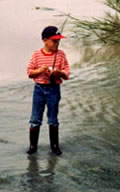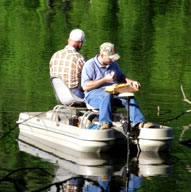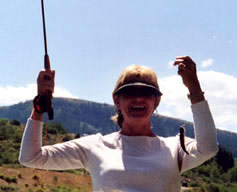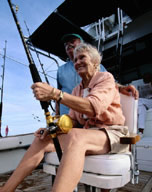Thomas J. Parr, M.D., F.A.C.S.
| |||||
| WELCOME • ABOUT DR. PARR
• PATIENT INFO • en español SPORTS MEDICINE • ARTICLES/LINKS • CONTACT US • PAY YOUR BILL ONLINE |
|||||
|
||||||||
FishingFishing has its origins in ancient times when fishing was necessary to feed the local populations. Today, fishing is still a source for food, but it also is one of our modern recreational sports. It can be an inexpensive activity with just a cane pole, a hook, and some worms. Or it can be as expensive as you choose to make it. I know one fisherman who paid many thousands of dollars to paint schools of fish on the bottom of his boat to try to attract fish. I was told it worked: he won a fishing competition, and now has a $10 trophy on his mantle to prove it. As long as the safety rules are followed, fishing is an excellent recreational sport for families. Fishing also can be a good escape from the pressures of our modern lives. FISHING LURE EYE INJURIES: OTHER COMMON INJURIES: It is important to keep your tetanus vaccinations current if you plan to fish. If you cannot remember when you had your last tetanus shot, contact your doctor to see if you need to get another one. Wound infections which seem to have begun shortly after fishing should not be ignored. These include sores, blisters, puncture wounds and other breaks in the skin. If you have a weak immune system, you need to be especially careful about exposure to bacteria and viruses found in streams, rivers, and salt water while fishing. Wounds can become infected with Vibrio vulnificus bacteria from contact with the warm coastal waters of the Gulf of Mexico. Problems with this type of bacteria are more likely to occur during the warmer months of May through October (similar to Hurricane Season). If you become ill a few hours to a few days after being exposed to these waters or if you develop redness and inflammation around a puncture wound, you should seek medical attention immediately. Delayed medical care could result in losing a limb or even in death. Casting is a repetitive activity and can lead to relatively mild overuse problems. Timothy J. McCue, MD (Curry Health Center, The University of Montana, Missoula, MT) researched overuse injuries in fly fishing. His study, "Upper Extremity Pain Seen With Fly-Casting Technique: A Survey of Fly-Casting Instructor" was published in Wilderness and Environmental Medicine. The results of the study were that of the surveyed instructors, 50% reported pain in the shoulder, 39% reported pain in the elbow, and 36% reported having had pain in the wrist from repetitive casting. Overhead casting seemed to cause less frequent pain than other types of casting. SAFETY RECOMMENDATIONS: Keep a fully charged cell phone on you in a waterproof bag in a zippered pocket at all times. (You can't call for help if you leave it in the car or if it gets into the water.) If you frequently fish where there are no cell phone antennas nearby, consider getting a satellite phone. Wear a life jacket any time you are near or on the water. It will help protect you if you should slip and accidentally fall into the water, which does happen from time to time and is always unplanned. It is concerning to read in fishing blogs of so many people admitting to having almost drowned while fishing, and and yet they continue to not regard a life jacket as an important safety requirement while fishing. Don't fish barefooted or in flip-flops. Wear sturdy, protective, non-slip shoes or boots. One of my most "memorable" fish injury patients presented with a very infected foot from stepping on a catfish spine. Be sure to have adequate drinking water with you and stay well hydrated. Wear a hat with a durable front visor (to help protect your face from an out-of-control lure, as well as from the rays of the sun), sunscreen, and protective, polarized sunglasses (either AOA approved or wrap-around). Also wear durable clothing appropriate to protect your legs and arms from scrapes and cuts. In colder weather, dress in layers rather than in bulky winter clothing (which would absorb too much water if you fall in). If it is summertime, you need your clothing to be durable, protective, and light weight. Always carry a waterproof first aid kit with you. It should include wire cutters, utility scissors, antibiotic ointment, antiseptic towelettes, sting relief ointment, antihistamine capsules or tablets, ibuprofen tablets, moleskin bandages, adhesive tape, sterile gauze pads, roll of conforming gauze, and a variety of band-aids including knuckle band-aids. It is best to just cut off the excess part of an imbedded lure and immediately go for professional medical help, instead of trying to remove it yourself. Because today's lures are so sharp and jagged, you could do much more damage trying to remove it yourself. Wear gloves while fishing to protect from bacteria in the water and on the fish you catch and have to handle. Use one of the antibacterial hand sanitizer gels or Clorox wipes several times each day while out fishing, or you can use a mixture of 1 part bleach to 3 parts clean water (prepared at home and safely stored in a plastic container). If you have cuts or skin sores, consider staying out of the water altogether until they have healed. Keep a collapsible or telescoping wading staff with you. They are helpful getting down and back up slippery banks, and occasionally to keep snakes at an appropriate distance. It is best to wear your wading staff on you in its holster so you will have it within reach when you need it. Pay close attention to the weather forecasts and always watch for unexpected changes in weather conditions. When doing salt water fishing, also watch for unexpected tide and swell conditions. Take weather warnings and unexpected weather changes seriously and head for shelter or shore as soon as you can, rather than "in a little while" when it could become a lot more dangerous. — Tom Parr, M.D. |
COMMON SPORTS INJURIES & SAFE PARTICIPATION
Baseball & Softball
SPORTS MEDICINE RECOGNITION
Recognized as one of the "Top Sports Medicine Orthopedic Surgeons in the USA" by Castle Connolly. Dr. Parr has been named as an "Outstanding Orthopedic Surgeon of Texas", as seen in SPORTS ILLUSTRATED.
SPEAKER'S PROGRAM:
|
|||||||
| 14090 Southwest Freeway #130 Sugar Land TX 77478 Phone: 281-491-7111 |
© Copyright 2009-2018 Thomas J. Parr, M.D. |





